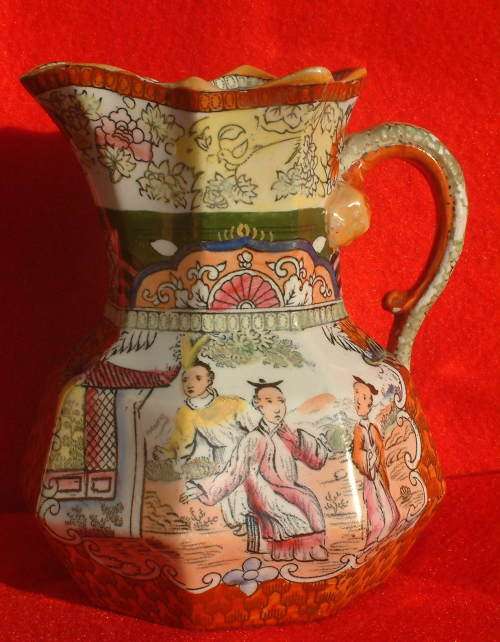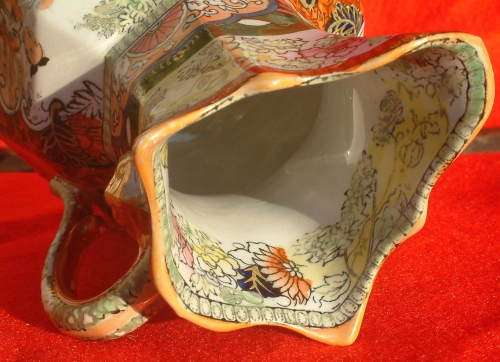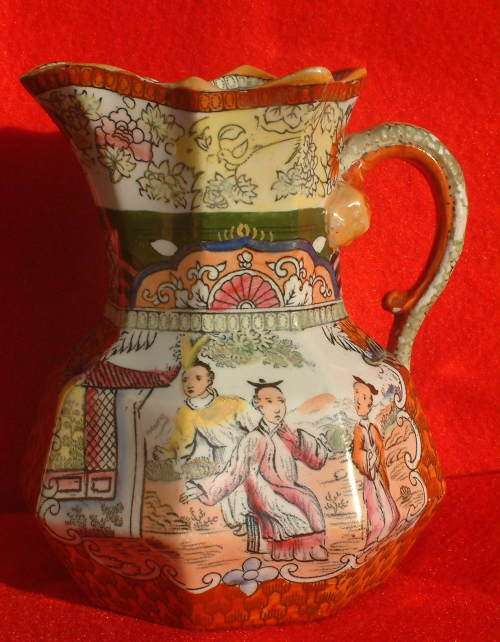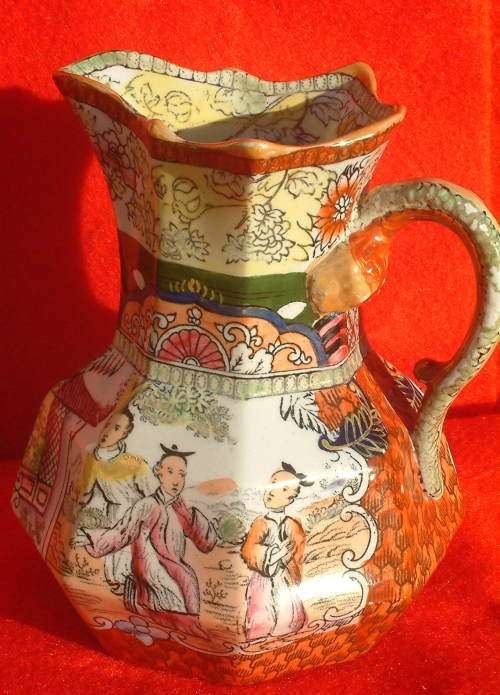Antique Mason's Ironstone Jug, C.1830-1848, Red Scale Conversation pattern. Ref.J.11
 ‘A process for the ‘Improvement of the Manufacture of English Porcelain’ this consists of using scoria or slag of Ironstone pounded and ground in water with certain proportions of flint, Cornwall stone and clay, and blue oxide of cobalt.' So read the new patent, Number 3724, of Charles Mason, on July 31st, 1813. This patent was granted for a period of fourteen years. But, who was Charles Mason? Well he was the son of Miles Mason (1752-1822) a well-known potter from Staffordshire, and his wife, Ruth Farrer. Working alongside his father, Miles, they both came up with this new earthernware formula, naming it 'Ironstone China' Although not really ironstone (it had less than 1%) nor was it 'porcelain', the name caught on. The products produced were of a very high quality and extremely hard and they became an immediate success. The Chinoiserie (Chinese) patterns were similar to the designs found on imported Chinese Imari ware, but, the articles were reasonably priced. Only the top artists and craftsmen were employed, although the transfer-printed items were hand-coloured by children, often as young as seven years.
‘A process for the ‘Improvement of the Manufacture of English Porcelain’ this consists of using scoria or slag of Ironstone pounded and ground in water with certain proportions of flint, Cornwall stone and clay, and blue oxide of cobalt.' So read the new patent, Number 3724, of Charles Mason, on July 31st, 1813. This patent was granted for a period of fourteen years. But, who was Charles Mason? Well he was the son of Miles Mason (1752-1822) a well-known potter from Staffordshire, and his wife, Ruth Farrer. Working alongside his father, Miles, they both came up with this new earthernware formula, naming it 'Ironstone China' Although not really ironstone (it had less than 1%) nor was it 'porcelain', the name caught on. The products produced were of a very high quality and extremely hard and they became an immediate success. The Chinoiserie (Chinese) patterns were similar to the designs found on imported Chinese Imari ware, but, the articles were reasonably priced. Only the top artists and craftsmen were employed, although the transfer-printed items were hand-coloured by children, often as young as seven years.
One of the most popular items Mason's produced were his Jugs, and, especially,the octagonal shapes which had snake or tree handles. Other companies which copied Mason's designs were Turner, Spode, Hicks and Meigh, Ridgeway, Davenport, to mention a few.
The jug offered above stands 15.5cm high and has a diameter of 11.5cm. It has one of the sought after Chinoiserie patterns with oriental people, called the "Red Scale Conversation Group" as documented on page 77 of "A Guide to Mason's Patent Ironstone Patterns, c 1813 to c 1848," published by The Masons Collectors' Club. The pattern is hand-painted in very bold enamels over a printed outline. However, there were definitely two issues of this pattern, one, similar to the jug offered above, has more detail in the 'scales' as well as the Chinese figures. The second pattern shows far less detail.However, this pattern is known as far back as 1825 and is likely to have been reissued and engraved a number of times. I have not been able to determine which came first.
The base of the Jug has a clear angular crown mark, with Mason's above, printed in Black, which dates it to circa 1835. It remains in very good condition, and shows no chips, cracks or damage apart from some flaking of the green enamel on the handle. Having a high content of arsenic, the green enamel was difficult to fire and consequently suffered from some flaking.


Please note, I am NOT a qualified archaeologist/antiquarian and the description I have given is based on research of the subject.
This is a genuine antique. The classification of an 'antique' is that it should be 100 years old, OR MORE. There are many articles being offered as 'antiques' when, clearly, they are not.
Price R850.00
Post R75.00
Terms: We offer a strict three-day approval period from the date the parcel reaches you. Refunds/credits are based on the cost of the article, NOT including delivery charges. Please advise us within this period whether you would like to return any article for a refund/credit. Although we pride ourselves in our packing, the buyer remains responsible for loss, non-arrival or damage to goods being sent to, or returned.


 ‘A process for the ‘Improvement of the Manufacture of English Porcelain’ this consists of using scoria or slag of Ironstone pounded and ground in water with certain proportions of flint, Cornwall stone and clay, and blue oxide of cobalt.' So read the new patent,
‘A process for the ‘Improvement of the Manufacture of English Porcelain’ this consists of using scoria or slag of Ironstone pounded and ground in water with certain proportions of flint, Cornwall stone and clay, and blue oxide of cobalt.' So read the new patent, 



